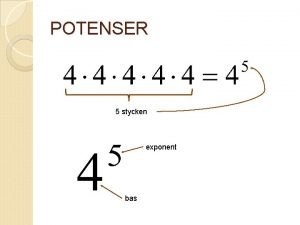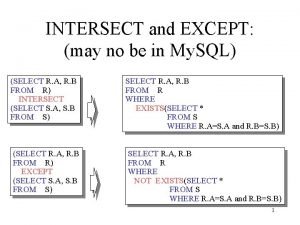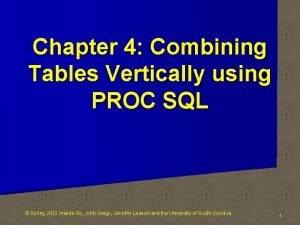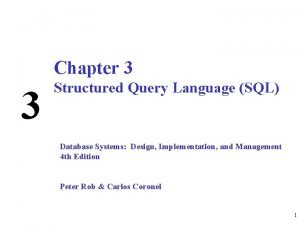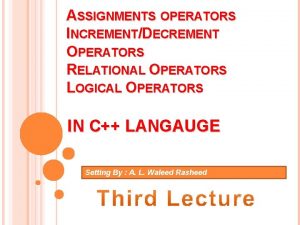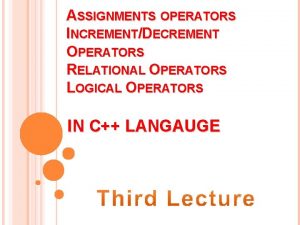Set operators UNION UNION ALL MINUS INTERSECT SQL
![Set operators (UNION, UNION ALL, MINUS, INTERSECT) [SQL] Set operators (UNION, UNION ALL, MINUS, INTERSECT) [SQL]](https://slidetodoc.com/presentation_image_h/a24b50f0542f1c65d07ca0bd6e1b1aa2/image-1.jpg)
![Set operators (UNION, UNION ALL, MINUS, INTERSECT) [SQL] • select col_1, col_2, col_3, . Set operators (UNION, UNION ALL, MINUS, INTERSECT) [SQL] • select col_1, col_2, col_3, .](https://slidetodoc.com/presentation_image_h/a24b50f0542f1c65d07ca0bd6e1b1aa2/image-2.jpg)










- Slides: 12
![Set operators UNION UNION ALL MINUS INTERSECT SQL Set operators (UNION, UNION ALL, MINUS, INTERSECT) [SQL]](https://slidetodoc.com/presentation_image_h/a24b50f0542f1c65d07ca0bd6e1b1aa2/image-1.jpg)
Set operators (UNION, UNION ALL, MINUS, INTERSECT) [SQL]
![Set operators UNION UNION ALL MINUS INTERSECT SQL select col1 col2 col3 Set operators (UNION, UNION ALL, MINUS, INTERSECT) [SQL] • select col_1, col_2, col_3, .](https://slidetodoc.com/presentation_image_h/a24b50f0542f1c65d07ca0bd6e1b1aa2/image-2.jpg)
Set operators (UNION, UNION ALL, MINUS, INTERSECT) [SQL] • select col_1, col_2, col_3, . . . col_n from table_1 set operator select col_1, col_2, col_3, . . . col_n from table_2 set operator. . . select col_1, col_2, col_3, . . . col_n from table_n; • The four set operators union, union all, intersect and minus allow to serially combine more than one select statements. Although more than one select statement will then be present, only one result set is then returned.

• For the demonstration of set operators, the following test tables are created: • create table_1 ( col_1 number, col_2 varchar 2(10), col_3 date ); • create table_2 ( col_1 number, col_2 varchar 2(10), col_3 date );

• Then, a few values are inserted: • insert into table_1 values ( 3, 'hello' , to_date('28. 08. 1970')); • insert into table_1 values ( 42, 'galaxy', to_date('01. 2001')); • insert into table_1 values (100, 'bye' , to_date('09. 02. 2004')); • insert into table_2 values ( 3, 'bye' , to_date('28. 08. 1970')); • insert into table_2 values ( 42, 'galaxy', to_date('01. 2001')); • insert into table_2 values ( 60, 'bye' , to_date('09. 02. 2004')); • insert into table_2 values ( 3, 'hello' , to_date('05. 2002'));





SUBQUERIES • A query nested within a query is known as subquery. • For example, you want to see all the employees whose salary is above average salary. For this you have to first compute the average salary using AVG function and then compare employees salaries with this computed salary. This is possible using subquery. Here the sub query will first compute the average salary and then main query will execute. • Select * from emp where sal > (select avg(sal) from emp); • Similarly we want to see the name and empno of that employee whose salary is maximum. • Select * from emp where sal = (select max(sal) from emp); • To see second maximum salary • Select max(sal) from emp where sal <(select max(sal) from emp);

• • Similarly to see the Third highest salary. Select max(sal) from emp where sal < (select max(sal) from emp Where sal < (select max(sal) from emp)); • We want to see how many employees are there whose salary is above average. • Select count(*) from emp where sal > (select avg(sal) from emp);

• We want to see those employees who are working in Hyderabad. Remember emp and dept are joined on deptno and city column is in the dept table. Assuming that wherever the department is located the employee is working in that city. • Select * from emp where deptno in (select deptno from dept where city=’HYD’); • You can also use subquery in FROM clause of SELECT statement. • For example the following query returns the top 5 salaries from employees table. • Select sal from (select sal from emp order sal desc) where rownum <= 5;

• To see the sum salary deptwise you can give the following query. • Select sum(sal) from emp group by deptno; • Now to see the average total salary deptwise you can give a sub query in FROM clause. • select avg(depttotal) from (select sum(sal) as depttotal from emp group by deptno);
 Union union all intersect
Union union all intersect Grundpotensform
Grundpotensform Intersect in sql
Intersect in sql Outer union corr sql
Outer union corr sql Total set awareness set consideration set
Total set awareness set consideration set Training set validation set test set
Training set validation set test set Pl sql meaning
Pl sql meaning Logical operators in pl sql
Logical operators in pl sql A structured query language – sql operators are
A structured query language – sql operators are Set theory operators
Set theory operators Name all the rays
Name all the rays Difference between pl/sql and sql
Difference between pl/sql and sql Oracle sql developer real time sql monitoring
Oracle sql developer real time sql monitoring

